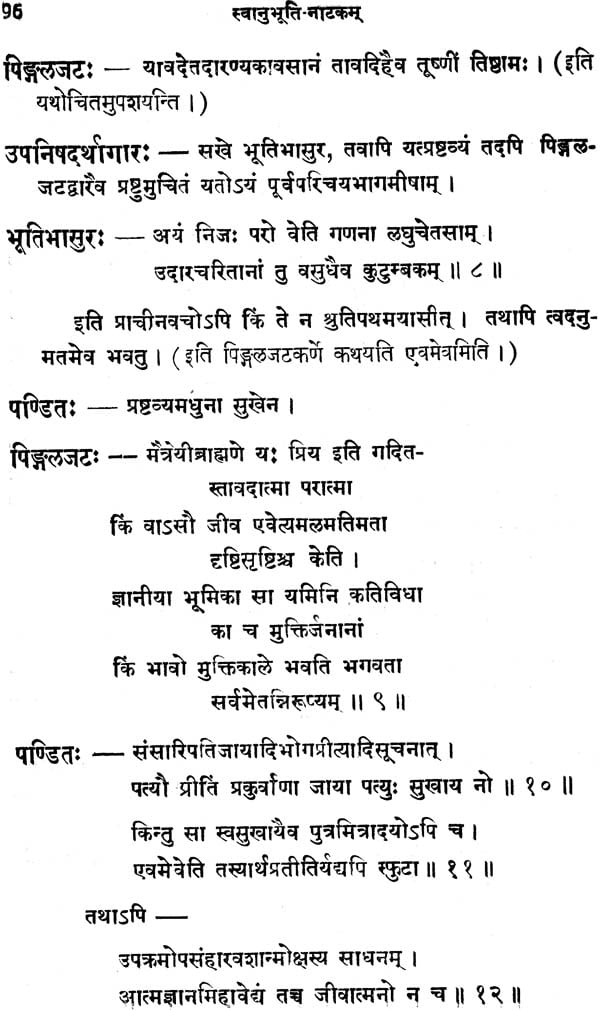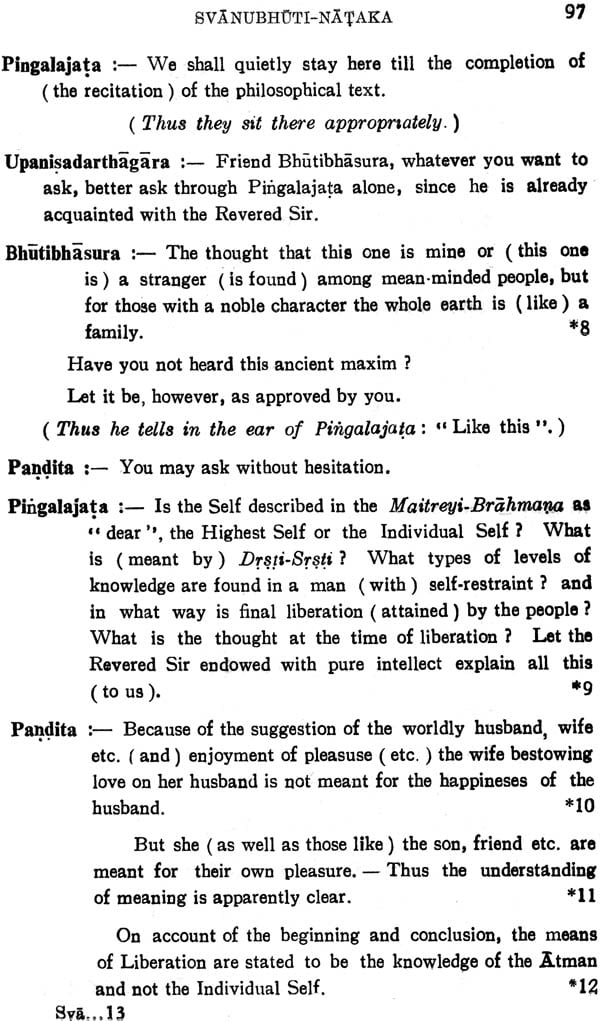
Svanubhuti-Nataka (The Play Entitled Svanubhuti. "Self Realisation") -An Old and Rare Book
Book Specification
| Item Code: | NAK918 |
| Author: | Ananta Pandita |
| Publisher: | Bhandarkar Oriental Research Institute, Pune |
| Language: | Sanskrit Text With English Translaiton |
| Edition: | 1990 |
| Pages: | 206 |
| Cover: | Paperback |
| Other Details | 8.5 inch X 5.5 inch |
| Weight | 270 gm |
Book Description
I have always said – perhaps a little hyperbolically – that Sanskrit literature is like an iceberg in the sense that what we actually see of it is only its tip while a larger part of it still remains submerged in the ocean of manuscripts. All Serious researchers in the field of Sanskrit studied ought, therefore, to regard it as one their major obligations to bring to light this long buried treasure. Dr (Mrs) Uma S. Deshpande deserves our sincere encomium for having requited her obligation in this regard in a very creditable manner through her ciritical edition of Anantha Pandita’s play Svanubhuti.
Sanskrit authors are seen to have put their dramatic talent to good account in a variety of ways. Ananta Pandita who hailed from Punyastambha or punatamba (one is here naturally reminded of another stalwart who is believed to have hailed from Punyastambha about the last quarter of the seventeenth century A.D., namely, Nilakantha Caturdbara, the famous commentator of the Mahabharata) has attempted a remarkable exercise in dramatizing the teachings of Advaita Vedanta through his drama, Svanubhuti, presumbably hoping that those teachings would thereby reach a large audience. I am glad to see that Dr. (Mrs) Deshpande has, in the work scrupulously and intelligently adhered to all the essential tenets of critical editing.
I have known Dr. Deshpande for the last few years and am greatly impressed by her keenness for higher research in Sanskrit. I wish she gets suitable opportunities to adequately exploit that keenness.
I have great pleasure in introducing to the world of scholars the play Svanubhutinataka of Ananta Pandita from Punyastambha (modern Puntambe in Maharashtra) of the 17th century A. D., edited critically for the first time and translated into English with a detailed Introduction giving information about the author and his works, the plot of the play, its characters as also its philosophy, by Dr. Mrs. Uma Deshpande, who is fortunate to have got two manuscripts of the work, one from Baroda and .the other from Jaipur, for constituting the text. This gave her the opportunity to compare the readings and to fill up the lacunae.
Sanskrit drama goes back to a hoary past. Its origin is still shrouded in mystery. Attempts by scholars have traced it back to at least a couple of centuries before Christ. Meant originally to be put on the stage, technically termed a Drsyakavya, it later turned into a form of literature more to be read than to be put on boards, thanks to the decline of the Sanskrit stage. The present play belongs to the stage of being read rather than being performed. As a piece of literature it has everything to commend itself, Its elegant expression, its chaste style, its charming diction. It has, however, little of stage worthiness. It has few short and crisp dialogues, and has instead long ones with lengthy compounds. Characters are introduced just for the sake of introduction, with little of dramatic justification. There is a tendency, apiece with the period of the play, of a display of pedantry. There is an attempt at embellishing the work with alliteration of all types including the final one, the Antyanuprasa and Yamaka, to the extent of sacrificing, in an odd case or so, even the propriety of the expression, e. g. the cerebral in karyakaryavi-marsanam in place of the regular vimarsanam on account of the following like-sounding satsampadam harsanam and other similar- sounding expressions. There are attempts occasionally at the use of made-up words, e. g., Mrdaniparivrdhaya, the husband (lit. lord) of Mardani i. e. Parvati, or in other words Siva. One can have a peep through the work Into some of the modernisms too. A case In point is the use of cet in the beginning of a pada which older Sanskrit Idiom does not permit. In line with this is the expression:. A lengthy conversation between a Pandita and a Tarkika touching on the intricate problems of Vedanta and Nyaya is ill-suited to a play though it may go very well with a philosophical text. The work as it is has a thin veneer of a drama and not the full-developed technique as enunciated in the celebrated works on Sanskrit dramaturgy. Its philosophy seems to overshadow its dramatic aspect. The author had a definite aim in composing the work: to propagate Absolute Monism, the Advaita Vedanta as expounded by Sankara, the aim in which he seems to have succeeded most eminently. The dramatic form he adopted in the belief, perhaps that it would enable him to reach out to the discerning readers more easily by presenting to them something in a form and garb which may motivate them towards his avowed aim.
Dr. Mrs. Uma Deshpande deserves all praise for bringing to light a learned work like the present one which had been lying in oblivion all these centuries. Her English translation betrays her thorough grasp of the text of the play which being weighted with philosophy is certainly abstruse at places. Her introduction throws light on many an obscure point about the play and the playwright. She has worked hard to make a success of her difficult assignment ensuring for her deep and abiding gratitude of the scholarly world.
| Foreword by Professor R.N. Dandekar | vii | |
| Preface by Professor Satya Vrat Shastri | viii-ix | |
| Acknowledgements | x-xi | |
| Introduction | I-62 | |
| Text With English Translation | 1-171 | |
| Appendices | ||
| I | Bibliography | 174-181 |
| II | Index to Verses together with Vrttas and Alankaras | 182-189 |
| III | Index to Subhasitas | 190-195 |
| Errata | 196 |







